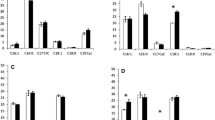Abstract
In addition to their role in the virulence attenuation of Salmonella and other pathogens, dam or seqA genes increase the sensitivity towards hydrogen peroxide. The aim of our study is to investigate the effect of H2O2 on the motility, the catalase and superoxide dismutase activities of dam and/or seqA mutants of Salmonella typhimurium. Our findings showed significant differences of the effects of H2O2 on the motility between wild type strain and all of mutants. Hydrogen peroxide changes SOD isoenzyme profile of these mutants by disappearance of Fe-SOD. Concerning the catalase, an increase of its activity was observed in the wild type, dam and seqA mutant. However, H2O2 decreases the activity of this enzyme in the double mutant strain. We can suggest that the dam gene, together with seqA, play a protective role in the oxidative stress response of Salmonella typhimurium.


Similar content being viewed by others
References
Beauchamp CO, Fridovich I (1971) Superoxide dismutase: improved assays and an assay applicable to acrylamide gels. Anal Biochem 44:276–287
Beers RF, Sizer IW (1954) Sulfide inhibition of catalase. Science 120:32–33
Blyn LB, Braaten BA, Low DA (1990) Regulation of pap pilin phase variation by a mechanism involving differential dam methylation states. EMBO J 9:4045–4054
Buchmeier NA, Libby SJ, Xu Y, Loewen PC, Switala J, Guiney DG, Fang FC (1995) DNA repair is more important than catalase for Salmonella virulence in mice. J Clin Invest 95:1047–1053
Carlsson J, Berglin EH, Claesson R, Edlund M-BK, Persson S (1988) Catalase inhibition by sulfide and hydrogen peroxide-induced mutagenicity in Salmonella typhimurium strain TA102. Mutat Res 202:59–64
Chatti A, Daghfous D, Landoulsi A (2007) Effect of seqA mutation on Salmonella typhimurium virulence. J Infect 54:e241–e245
Chatti A, Landoulsi A (2008) L’état de la méthylation de l’ADN régule la virulence et la réponse au stress chez Salmonella. CR Biologies 331:648–654
Chatti A, Daghfous D, Landoulsi A (2008) Effect of repeated in vivo passage (in mice) on Salmonella typhimurium dam mutant virulence and fitness. Pathol Biol 56:121–124
Farr SB, Kogoma T (1991) Oxidative stress responses in Escherichia coli and Salmonella typhimurium. Microbiol Rev 55:561–585
Giacomodonato MN, Sarnacki MH, Caccuri RL, Sordelli DO, Cerquetti MC (2004) Host response to a dam mutant of Salmonella enterica serovar Enteritidis with a temperature sensitive phenotype. Infect Immun 72:5498–5501
Groisman EA, Heffron F (1995) Regulation of Salmonella virulence by two-component regulatory systems. In: Hoch JA, Silhavy TJ (eds) Two-Component Signal Transduction. American Society for Microbiology Press, Washington, DC, pp 319–332
Hassett DJ, Cohen MS (1989) Bacterial adaptation to oxidative stress: implications for pathogenesis and interaction with phagocytic cells. FASEB J 3:2574–2582
Heithoff DM, Sinsheimer RL, Low DA, Mahan MJ (1999) An essential role for DNA adenine methylation in bacterial virulence. Science 284:967–970
Heithoff DM, Enioutina EY, Daynes RA, Sinsheimer RL, Low DA, Mahan MJ (2001) Salmonella DNA adenine methylase mutants confer cross-protective immunity. Infect Immun 69:6725–6730
Jakomin M, Chessa D, Baumler AJ, Casadesus J (2008) Regulation of the Salmonella enterica std Fimbrial operon by DNA adenine methylation, SeqA, and HdfR. J Bacteriol 190:7406–7413
Loui C, Chang AC, Lu S (2009) Role of the ArcAB two-component system in the resistance of Escherichia coli to reactive oxygen stress. BMC Microbiology 9:183
Nicholson B, Low D (2000) DNA methylation-dependent regulation of pef expression in Salmonella typhimurium. Mol Microbiol 35:728–742
Parkinson JS, Kofoid EC (1992) Communication modules in bacterial signaling proteins. Annu Rev Genet 26:71–112
Vazquez-Torres A, Jones-Carson J, Mastroeni P, Ischiropoulos H, Fang FC (2000) Antimicrobial actions of the NADPH phagocyte oxidase and inducible nitric oxide synthase in experimental salmonellosis. I. Effects on microbial killing by activated peritoneal macrophages in vitro. J Exp Med 192:227–236
Yallaly P, Eisenstark A (1990) Influence of DNA adenine methylase on the sensitivity of Escherichia coli to near-UV radiation and hydrogen peroxide. Biochem Biophys Res Commun 169:64–69
Acknowledgments
This work was supported by: « Ministère de l’Enseignement Supérieur; Faculté des Sciences de Bizerte-Département de Biologie » . We thank Pr. Casadesus J. for providing Salmonella strains.
Author information
Authors and Affiliations
Corresponding author
Rights and permissions
About this article
Cite this article
Chatti, A., Messaoudi, N., Mihoub, M. et al. Effects of hydrogen peroxide on the motility, catalase and superoxide dismutase of dam and/or seqA mutant of Salmonella typhimurium . World J Microbiol Biotechnol 28, 129–133 (2012). https://doi.org/10.1007/s11274-011-0801-8
Received:
Accepted:
Published:
Issue Date:
DOI: https://doi.org/10.1007/s11274-011-0801-8




